Fire starter projects are a prepper’s best friend, don’t you think? I mean, being able to start a fire in case of an emergency could save your skin from cold and your stomach from hunger.
Fire was humankind’s protector for centuries; it used to shield us from wild animals, keep us warm and help cook our food. We still use it for basically the same purposes, even today where everything is smart and digitalized and we don’t even have to think much to survive if we don’t want to. There’s an app that does it for us, right?
What I am trying to tell you, folks, is that fire is one of the most important technological achievements for humankind; just think about the ancient Greek myth of Prometheus, the Titan who stole fire from Mount Olympus and gave it to humans. For that noble gesture, he was banished and suffered horrible consequences.
In today’s article we’ll explore a few DIY projects about how to build your own fire starters using leftovers from the holidays, old stuff you didn’t recycle,or just scrap that you may have laying around. You can build them on the cheap with lots of fun involved in the process.
Knowing how to start a fire is also a great lesson to teach your kids, especially if you’re into prepping and DIY. Learning useful stuff while you’re still young instead of playing meaningless, mind-numbing, spirit-crushing video games is preferable in my opinion, especially in this day and age, when people are increasingly helpless and dependent upon the good ol’ government or community resources.
The ancient art of starting a fire must be preserved at all costs and that’s why we’re here today.
1. DIY “Muffin” Fire Starters from Lint and Papers
The first fire starter project I want to tell you about caught my attention because it’s about what I’ve already discussed in the beginning of this article; how to motivate your kid into DIY-ing useful stuff. This project is an engaging and fun activity for you and your “mini-you” and involves basic materials and minimal skill levels.
All you’ll need in terms of gear and materials for this fire starter project is old newspaper, dryer lint, a paper shredder and leftover wax. Basically it’s a variant of the already-classic egg carton-and-dryer lint idea with a twist of cuteness. The cutest thing about this project is that the fire starters ended up looking like candy, making for the perfect learning experience for younger kids.
Just don’t let them eat it!
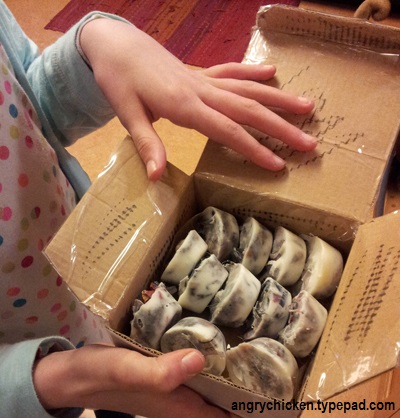
Source: Angry Chicken
2. DIY Self-Igniting Fire Starter
The next project I’ll tell you about is a bit more complex and it will help you create self-igniting fire starters. I mean, this is the next level in fire-starting technology, right? The self-igniting fire starter features three components: the ignition source (a Strike Anywhere match), a flame accelerant (toilet paper) and fuel (paraffin).
Even if it may sound complex, the project is very easy to do and as smart as it gets. Basically, all you have to do is to take a Strike Anywhere match, wrap it tightly in toilet paper (you must leave the striking head sticking out) and dip it in paraffin.
Next, you’ll have to let it dry thoroughly; the end result will be a completely waterproof, self-igniting fire starter; the perfect companion for your outdoor adventures and a reliable tool for emergency situations.
All you need to remember is that you’ll have to scrape the paraffin off the match’s head before you strike it or else it won’t ignite; also, rough up the toilet paper coating around the head of the match to expose a few fibers to the flame. You can use your fingernail for that – it’s relatively easy.
It’s pretty straightforward folks.
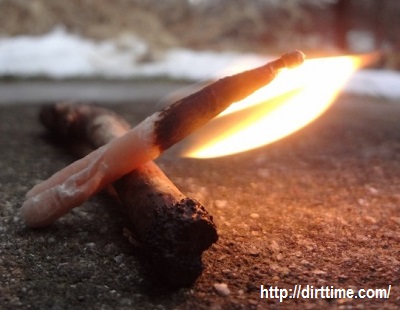
Source: dirttime.com.
3. The Classic DIY Fire Starter
Now, let’s see about a classic in the field, the how-to-make-a-free-fire-starter-using-egg-cartons-and-dryer-lint. Seriously, I’ve already told you about a variant of this project in my first example, now here comes the real, original deal folks! Being a practically free DIY project, this involves gathering used stuff from your home including empty egg cartons (I eat eggs like a fox!) and dryer lint that you already have floating around your basement or something.
You’ll end up creating magic little balls of fire that are able to burn for 10 to 15 minutes after they’re lit, which makes them the perfect accelerant for starting a fire even if the wood is not perfectly dry.
You can keep them in your bug out bag or in your car for emergency situations. Just remember that if you’re going to put them in the car, you may want to keep them in baggies so that they don’t melt all over your interior.
Here’s the list of what you’ll need: any variety of dry lint, cardboard or pressed paper egg carton(s) and wax. Wax can be scrapped from virtually any source: crayons, old candles (even some used candles from the thrift store if you don’t have them around the house) or you can even go on a huge buying spree and get yourself some good ol’ paraffin from your local hardware store for about 2 bucks a quart.
Either way, if you manage to get these things together, you’re golden and almost done, because the process is so simple that even a kid can do it on a bad day. The magic goes something like this: you take the egg carton and you stuff the dryer lint there.
Be careful not to stuff the lint too tight or else the wax won’t be able to penetrate the lint ball, compromising its burning abilities. Next, melt the wax using a container of some kind that you don’t mind ruining and that won’t melt – an empty can is great for this.
Put the container in a pot of water, then heat the water (don’t put the can containing wax/paraffin directly on an open flame) so the wax melts inside the can. Don’t let any water get in the wax, though. Sit the egg carton on something you don’t value much, like a piece of cardboard or tin foil or whatever. You’re likely going to get wax on it.
When the wax is melted, you just scoop it or poor it directly onto the lint that’s in the egg carton and that’s about it. You’ll have to make sure that the lint is completely soaked in paraffin by using something like a fork to poke it and stir it around to be positive it’s totally soaked. Let your fire starter cool and harden and that’s all folks.
There are two ways of doing this: you can leave the egg carton intact (like an ice cube tray) or cut it up into individual parts and fill them with wax one by one. Personally, I make them while the carton is intact, then cut them apart when they’re finished.
Either way, the process is just the same, it’s just a matter of personal preference.
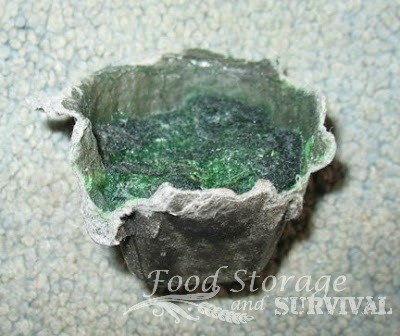
Source: Food Storage and Survival.
4. DIY Cork Fire Starter
Next, let me present you with maybe the easiest and funniest way of DIY-ing fire starters: the wine cork method. The funnest part of this project may be the fact that you’ll have to drink a lot of wine in the beginning to collect the “used” corks. There’s no other way around it, so bottoms up!
After you’ve collected a couple dozen wine corks (made out of real cork, not the plastic kind), just put them inside a glass jar along with copious amounts of rubbing alcohol(don’t drink that!) and let them soak in there for a while, sealed tightly of course.
Now, when you need to light a fire quickly, just grab a couple of corks from the jar and toss them under or in the kindling; the results will be spectacular. Have fun and drink in moderation; you know I’m just kidding about drinking all the wine, at least at once!
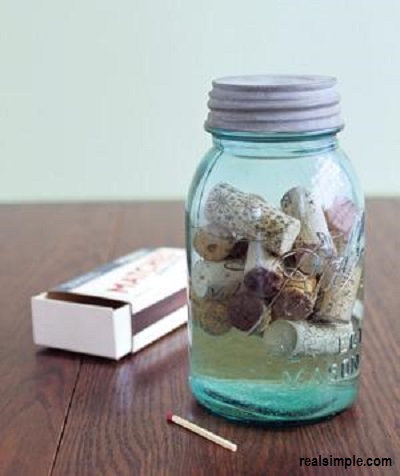
Source: Real Simple.
5. DIY “The Mop” Fire Starter
Another dirt-cheap DIY method for creating a fire starter is called “the mop method”. The basics are similar to the “egg carton” project, but instead of egg cartons you’ll use a mop head.
Mop heads are usually made from cotton (100%) which is basically the same stuff wicks are made from, and they usually cost under $5, depending on your source. If you use 1-inch strips you’ll end up with thousands from a single mop head, which translates into dirt cheap fire starters.
You’ll have to pull individual strands from the cotton mop head and soak them into melted wax and that’s basically it. Obviously, you must use a double-burner, as I already told you, which is much safer than melting wax directly on the heat source. If you’re not careful, wax will smoke and it may catch fire eventually.
The strips that you’ve pulled from the mop head must be soaked into the melted wax and removed, allowed to dry, cut into your desired size and voila! At 1-inch lengths they’ll burn for approximately 5 minutes each, giving you enough time to start a fire in almost any circumstance.
Source: Wokokon.
6. DIY Orange Fire Starter
What if I’ve told you that you can start a fire using orange peels? Yes, you can use orange peels for your fire starter DIY project. Oranges contain a special oil inside their skins that may be used to fuel the fire. An additional benefit of using orange peel as fire starters is that they smell awesome and they don’t leave as much residue in your chimney as paper does.
All you have to do is dry enough orange peels using a sheet pan or something similar and keep them inside a brown paper bag afterwards, along with a silica pack, in order to keep them fresh and dry. That’s it.
They’ll burn like a supernova once they’re perfectly dry and they make for an awesome gift for your friends, as fire starters, or even potpourri.

Source: Apartment Therapy.
7. DIY Fire Starter from Cotton Pads
Another interesting idea is to use cotton pads as fire starters. All you need for this simple and highly efficient DIY project is wax and some cotton pads. These cotton pad fire starters are perfect to have on you (in your bag or whatever) for emergency situations due to their small size and great burning power.
The manufacturing process is very simple and intuitive: you’ll have to melt the candle into liquid wax inside a pan, can or something similar. Using some tweezers, you’ll put a few cotton pads into the pan, soak them thoroughly until they’re soaked with melted wax, pull them out, let them dry and harden and that’s about it.
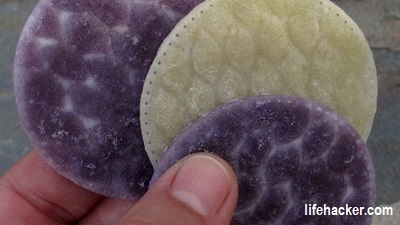
Source: Life Hacker.
And a bonus! We also have our own advice on DIY fire starter: just read Survivopedia’s tutorial with pictures about how to make easy DIY fire starters, and waterproof matches.
I hope my article helped you and if you have similar ideas, just feel free to comment in the dedicated section below.
This article has been written by Chris Black for Survivopedia.




























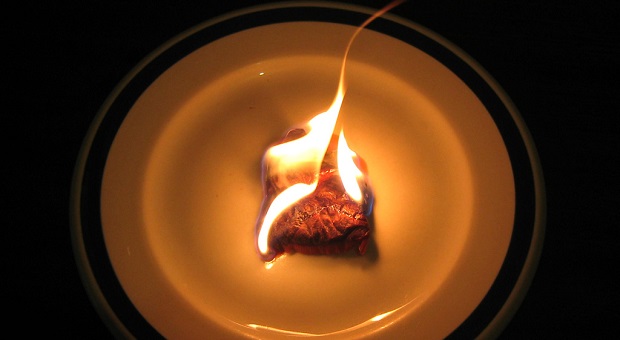








































I love the cotton pads one!
Also, corn chips (like Doritos and Fritos) make excellent fire-starters as well. My favorite is powdered coffee creamer, ala Mythbusters. (More of an accelerant than a starter I guess.)
Cotton balls with vaseline rubbed into them and stretched out into spikes work well. There is a reason vaseline rhymes with gasoline.
That’s cool! I will make done egg crate ones and mope end ones!! Great way to stock up on that camping fire kit. Especially for places that rain and no kindling to pick up, like on parks:). Being your own that works even in wet weather. Love it and thanks!!!
Cheers
Vicki
Don’t forget fried snack foods.A handful of corn chips burn quite quickly. They are loaded with cooking oil which is highly flammable. Try lighting a Frito Lay corn chip! You will be amazed.
Or the CRUNCHY Cheetos, four small Cheetos laid in a log cabin style for lighting a fire, WILL burn for 8-10 minutes.
Cotton balls slathered with petroleum jelly work very well too!
i’m very suprised no one seems to mention the sun as a way to melt the wax. if youhave a candle and just sit it in the sun it will melt. and f you have one of those jar candles or a votive candle in a glass container and set them in the sun theytoo will melt and become liquid. so why spend money to melt he wax? just take and put your candle stubs in a container, plastic, metal, wood etc… and set them in the summer sun and let them melt. ive had a 5 gallon plastic bucket full of scrap candles sitting in the sun and have them turn into a solid mess of wax , a jar candle sitting on the dash of your automobile on a sunny day for just 20 minutes it will be totally melted.even a wood fire costs money it takes physical energy to gather sticks for a fire, that energy did not come at zero cost. but the sun is free. ive used the sun to melt crayon pieces in ice cube trays to make solid blocks of crayons to use as candle colorants .
I also make some super starters using shredded paper, toilet paper rolls and wax. I stuff the toilet paper rolls moderately tight with shredded paper and then add 2 tablespoons of melted wax to the paper from each end. They burn for 5 -10 minutes and help hold the wood up for good ventilation for starting the wood.
All the above is fine and good. just not for me. I’ve carried a magnesium firestarter or Swedish steel rod for most all of the last 30 years. I say most cause you can’t take one on your person on a plane.
THESE ARE ALL GOOD IDEAS, BUT HAVE ANY OF YOU EVER GONE A FEW STEPS FARTHER AND MADE A STOVE AND A FIRE HOLDER TO COOK ON? IN GIRL SCOUTS, WE WOULD CUT STRIPS OF CORRUGATED CARDBOARD AND COIL THEM UP TIGHT IN A CLEAN TUNA FISH CAN WITH A WAX SOAKED COTTON STRING IN THE MIDDLE AS A WICK. THIS BURNER WAS PLACED UNDERNEATH A #10 EMPTY TIN CAN (CHECK WITH RESTAURANTS FOR FREE EMPTIES). REMOVE THE LID ENTIRELY IF STILL ATTACHED. USE A PUNCH TYPE CAN OPENER TO MAKE A VENT HOLE NEAR WHAT WILL BECOME THE COOKING SURFACE. CUT A 2″ FLAP ON THE OPEN END OF THE CAN ON THE OPPOSITE SIDE FROM THE CHIMNEY. LIGHT THE BURNER AND PLACE THE “STOVE” OVER THE BURNER. YOU CAN EASILY COOK AN EGG OR EVEN PANCAKES ON TOP OF THE STOVE. ADD A TINY AMOUNT OF COOKING OIL OR BUTTER TO THE STOVE TOP TO KEEP THE FOOD FROM STICKING. THESE BURNERS AND STOVES ARE LIGHT ENOUGH AND CHEAP ENOUGH TO HAVE ONE FOR EVERY ADULT AND TEEN IN THE FAMILY. (ALSO, THEY ARE FUN TO USE)
Here is an idea I saw on Man, Woman, Wild. A 9V battery and some steel wool. Get the finer steel wool. Also you do not need a whole lot of it either.
Waterproof firestartes – Straws from fast food places. Cut in 1 inch strips. Use
needle nose pliers and pinch one end leaving a little bit of staw exposed. Using
a lighter, melt the end pinched by the pliers. Now its sealed, take a cotton ball
soaked in petroleum jelly, pull apart and twist it, then shove it in the straw. Be
sure to leave a little space at the end, pinch with pliers again leaving a little bit
of straw to melt and seal. Now you have a waterproof fire starter. To use, cut
one end, pull a bit of cotton ball out and light.even in rain or high winds this
works extremely well. Have used this system for over 10 years. An altoids tin
is great to store them in. Have tins in my BOB, survival kit, car, ect. Nice to
do on rainy days, cold weather ect.
One thing I have used quite effectively for starting fires is a strip of birch bark. It burns well for the purpose. Contains oils which will easily ignite. I always keep some on hand in my survival kit.
I enjoy looking through an article that can make
men and women think. Also, thank you for permitting me to comment!